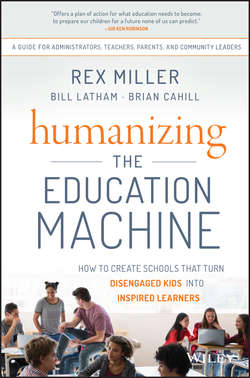Читать книгу Humanizing the Education Machine - Cahill Brian - Страница 10
На сайте Литреса книга снята с продажи.
CHAPTER 1
NUMBERS DON'T LIE
ОглавлениеYou never change things by fighting the existing reality.
To change something, build a new model that makes the existing model obsolete.
– R. Buckminster Fuller
Did you know that 70 percent of teachers have mentally checked out of teaching? How is that possible? These are not bad people. They all started out inspired, hopeful, courageous, and even playful. Some of our best novels and films – such as Dangerous Minds, Stand and Deliver, Lean on Me, Up the Down Staircase, and Goodbye, Mr. Chips —have featured these noble, exciting, and often daring figures.
But after a while, the Education Machine just rolled over too many teachers, mashing the life juices right out of their pores.
I'll tell you something else – by the time they graduate 60 percent of students will have also flown the coop. This is not some abstract number: these are the kids on your block, next door, and maybe in your upstairs bedrooms.
Public education does what it was designed to do. And in a previous era, that served America very well. With the passing of that era the model has become obsolete.
We all know that we live in perilous times. But, more than that, we live in the crumbling ruins of obsolete forms. An age is passing away (as ages always do). Don Berwick famously said, “Every system is perfectly designed to get the results it gets.” The prevalent model of public education does what it was designed to do. And in a previous era, that served America very well. With the passing of that era the model has become obsolete.
For that reason, the Education Machine is in genuine and panoramic crisis; it is in personal, social, economic, and national turmoil. Numbers don't lie. But that crisis is because of its obsolescence, not its malice.
Here are a few other features of its rot.
● The Education Machine does not have the capacity to care. And learning requires people who care.
● The Machine's continual cry of “reform” results in kicking the can down the road for future administrators and teachers to solve. This response only makes matters worse and costs a hell of a lot of money.
● We can't wait. We cannot let the Education Machine move another kid down its aged and rusty assembly line until they are broken or left behind. Now is already late.
So, how did we end up with an education system that has not only failed in its mission but has also inflicted so much psychological, emotional, and intellectual damage on so many people that it touches? But, far more important, what can we do about it now?
Now, let's pause and consider some other realities that our work on this book revealed:
● Yes, education has become a Machine. But schools, administrators, and teachers can create a kid-centered, human-enriching, and high-achieving learning experience.
● It takes stepping into only one classroom of engaged kids to see the difference between the Machine and the deeply human experience of learning.
● The challenge of education sounds formidable. But it can be brought down to a human scale and transformed through people who care.
Cynicism says we can't change what must be changed. That is not true; we can do something about it. This is not an impossible task. That is what this book is about. When you finish reading, you will know the time and money invested in this book was well worth the price. We can change the way we teach and train our younger members. Do not forget that.
Cynicism says we can't change what must be changed. That is not true; we can change the way we teach and train our younger members. Do not forget that.
I know what I'm talking about. Over the past two years, my associates and I have traveled thousands of miles and talked to hundreds of students, teachers, administrators, parents, suppliers, authors, and community leaders. We heard their stories of life in the Education Machine. Their time in education was, for too many, a soul-sucking, time-wasting, and stress-producing waste of effort. Not only that, it was a brutally demotivating and damaging experience.
But we also saw transformation. One of the most surprising features of our work was the discovery of fully absorbed, completely riveted students located clear across the K–12 spectrum; we met them in great cities and in small towns, in both “underserved” and resource-rich districts, and scattered across all the data points.
